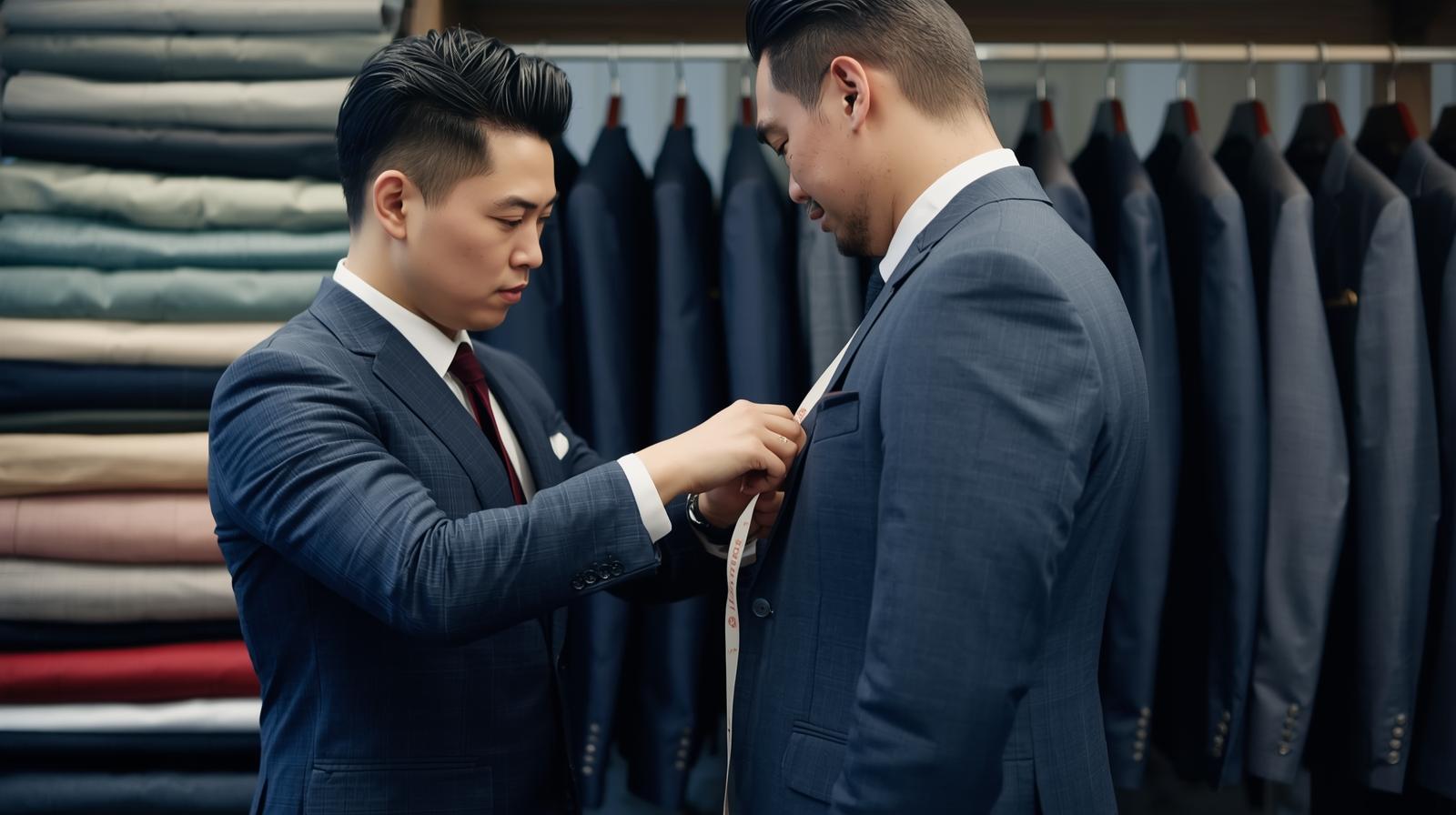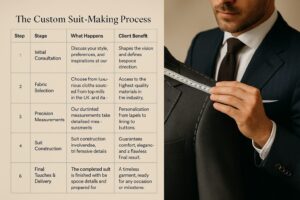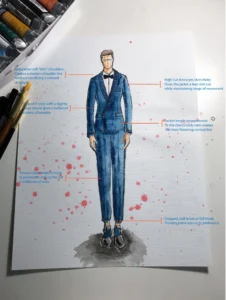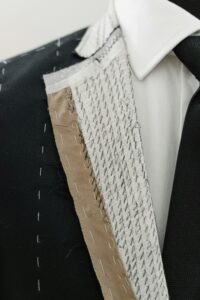





How to Design Your Own Custom Suit (Step-by-Step Guide)
Designing your own custom suit is not just about fabric and fit — it’s about exprssing your individuality through craftsmanship. A perfectly tailored suit can elevated your confidence, enhance your appearance, and last for years when designed with care.
In this step-by-step guide, Velour & Waza Custom Tailor Bangkok explains everything you need to know about designing your dream suit — from the first consultation to the final fitting (Fitting Tips for a Perfect Custom Suit Design). Whether it’s your first bespoke experience or your tenth, this guide will help you understand every stage with clarity and confidence.
Step 1:Define Your Purpose for Your Custom Suit

A perfect suit fit balances comfort and elegance — from shoulder to sleeve, every line matters.
Every great suit starts with a clear purpose. Before visiting your tailor, ask yourself what you need the suit for. Is it for business , a wedding, travel, or casual wear? Each occasion influences the fabric, desgn, and overall mood of your suit.
For example, a business suit bespoke suit should project authority and professionalism — usually in navy, charcoal, or dark gray. Meanwhile, a wedding suit can reflect your personality more freely with lighter shades, textures, and creative details.
Once your purpose is defined, gather inspiration. Browse fashion magazines, online galleries, and tailor portfolios. Save what resonates with you — lapel shapes, fabric colors, or full outfitt styles. When you bring these ideas to your tailor, they can visualize your aesthetic clearly.
After defining your visions, accurate measurements are the foundation of your design. A skill tailor takes more than 20 measurements to capture your body’s natural shape — chest, waist, hips, shoulders, arms, legs, and more.
Here are some key tips:
Always stand naturally, don’t puff your chest or suck in your stomach.
Measure over light clothing.
Double-check critical areas like shoulder width and sleeve length.
Each measurement helps create a paper or digital pattern that fit you perfectly. Even a small differnce — half an inch — can affect how the suit drapes or how comfortable it feels.
Fabric determines your suit’s comfort, style, and performance. The best way to start is to decide on the material, weight, and texture that fit your climate and lifestyle.
Wool: The classic choice for structure, breathability, and durability. Tropical wool works great in warmer regions.
Linen: Lightweight and airy, perfect for relaxed occasions. Wrinkles easily but looks effortlessly stylish.
Cotton: Smooth and versatile, ideal for business-casual looks.
Blends: Combining wool, silk, or linen for a unique balance of drape and strength.
Each fabric has its pros and cons, so choose based on how often and where you’ll wear the suitd. For instance, wool is timeless and formal, while linen gives off a cool, vacation-ready vibe.
fabric options for you to learn
Always feel the swatches before choosing. The way fabric drapes on your shoulder tells a lot about how it will move and breathe once tailored.
Now comes the fun part — customizing your suit’s design elements. Every small detail shapes your final look, from lapels to linings.
Single-breasted (2 buttons): classic, versatile, modern.
Double-breasted (6 buttons): elegant, formal, powerful silhouette.
Notch lapel style — timeless and safe for all occasions.
Peak lapel style— bold and formal, adds sharpness.
Shawl lapel style— perfect for tuxedos and dinner jackets.
No vent: classic but less flexible.
Single vent: easy movement, clean look.
Double vent: most comfortable and stylish for modern wearers.
Flat front: sleek and modern.
Pleated: more comfort and room in the thighs.
Cuffed hem: adds visual weight and balance.
Buttons: Horn, corozo, or metal — depending on your suit tone.
Lining: Choose from subtle silk or bold contrast.
Pocket style: flap, jetted, or patch — each defines your formality.
Every detail adds personality. If unsure, your tailor will guide you base on body type and occasion.
Once measurements and styles are finalized, the tailor drafts a personal pattern. This blueprint ensures your suit fits precisely to your posture and proportion. Some tailors also create a basted fitting — a rough version made from inexpensive cloth or partially stitched fabric — to test the fit.
During this stage, you’ll see your vision take shape. Move your arms, sit, and walk to check comfort. Discuss adjustments openly — this is the best time to tweak shoulder sloped, sleeve length, or waist shape before cutting the final fabric.
A good tailor will refine your pattern until it’s flawless, ensuring a smooth transition to the construction phase.
Now your chosen fabric is ready to be cut. This is where craftsmanship shines. Skilled tailors hand-cut fabric according to your pattern, aligning grain and weave perfectly.
Next comes assembly — stitching the jacket, attaching lapels, padding shoulders, and sewing the linig. Depending on the tailor’s techniqued, you may get a full-canvas, half-canvas, or fused construction.
Full canvas: Premium option. Natural canvas stitched throughout for structure and breathability.
Half canvas: Canvas only in chest and lapel area — lighter but still durable.
Fused: Machine-pressed interlining; more affordable but less breathable.
Each construction affects how your suit feels and ages. Full-canvass suits are investment pieces — they mold to your body over time.
Once the suit is half-constructed, you’ll have your first fitting. This step ensures that the proportions, silhouette, and balanced are correct. Expect the tailor to check:
Shoulder alignment
Sleeve length
Waist suppression
Trouser break
Walk, move your arms, and sit down to test comfort. Don’t hesitate to share feedback — communication is key. The tailor will pin, mark, and note adjustments before refining the garment.
This iterative process guarantee that your suit will fit like a second skin.
Finally, it’s time for the last fitting. The tailor ensures all adjustments are perfect — sleeves align with wrist bones, trousers break naturally over shoes, and buttons close smoothly.
At this stage, the suit is pressed, hand-finished, and carefully inspected. You’ll feel the difference immediately — the balance, comfort, and confidence of a suit madee just for you.
Ask your tailor for care advice:
Use a wooden hanger to maintain shoulder shape.
Dry-clean occasionally, not frequently.
Steam wrinkles instead of ironing.
With proper care(here is how to maintains our suite guide), your custom suit can last for many years — aging gracefully while keeping its shape.
Designing your own suit isn’t just about fabric and stitches. It’s about confidence — knowing that what you wear was made exclusively for you. Every time you put it on, you’ll feel the precision, comfort, and artistry that mass-produced garments can’t match.
At Velour & Waza Custom Tailor Bangkok, we take pride in guiding customers through this creative journey. From style consultation to the final press, we ensure your suit tells your story — professionally, elegantly, and authentically.
Ready to design your own custom suit?
Reserve your private fitting today and discover why true luxury is always custom-made.
Velour & Waza Custom Tailor Bangkok,
Phone: whats app +66 63 254 8496
Line ID: 0632548496


